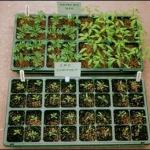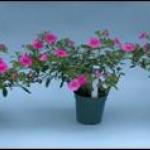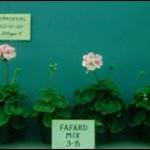Organic Growing Media and Fertilizers for Greenhouses
Organic methods of plant production are of increasing interest to many growers of horticulture crops including greenhouse operators. Some greenhouses are seeking "organic certification" in the same way as farmers of edible crops and livestock. The purpose of this article is to review the current status of "organic" growing media and fertilizers for greenhouse crop production.
It is said that the true organic grower is seeking to produce crops in "balance" or "harmony" with their environment so that finding chemical pesticide and fertilizer substitutes will be unnecessary. I believe this might true in outdoor crop production, but in the rather unique greenhouse environment this might not be readily achieved.
The greenhouse environment is very effective at promoting rapid plant growth, as well as insects and diseases in a short time period. Greenhouse crops are grown in small volume containers and they are irrigated frequently with large volumes of water. The combination of rapid plant growth, limited root volume, and frequent leaching make fertility management a challenge without the use of water-soluble chemical fertilizers.
Right now, because of the special challenges of growing in the greenhouse, it may be difficult for a traditional greenhouse grower to quickly transform into an "organic grower" without first looking for substitutes.
Personally I've got no problem with looking for organically acceptable substitutes for the traditional soilless growing media and chemical fertilizers. I believe that finding substitutes may be about the only way for most greenhouse growers have in immediate future to get into organic growing and that's what this piece is about.
Composting
Probably the first thing that comes to mind when we talk "organic" is composting and using the compost as a substitute for traditional soilless media.
The Basic Composting Process
The general steps in the biological process which creates compost are the same regardless of the raw materials being composted or the size and complexity of the production facility. A compost must pass through all of the steps outlined here in order for it to be considered of high enough quality for use in organic potting mixes.
The progress of organic matter decomposition during composting can be followed by monitoring the temperature of the compost pile. During the initial phase of composting the temperature of the pile increases rapidly as the population and activity of decay microorganisms increases in response to the readily decomposable carbon in the raw materials. The goals are to reach a temperature between 130°F or more and to maintain this temperature range until the microorganisms begin to exhaust the readily available carbon. Heating to these temperatures is critical for high quality greenhouse compost because it is in this range that weed seeds and most plant and human pathogens that might come from animal manure are killed. During composting the pile is turned and remixed several times to ensure complete heating and decomposition.
Following the high temperature phase there is an extended period of gradual temperature decline until the pile reaches ambient air temperature. Now, if the pile is turned, reheating will not occur. At this point the compost is said to be "near maturity", but to ensure that the compost is stable and ready to use, most producers allow some extra time for the compost to "cure". How long composting lasts varies with the method. It could take about 1-2 years in a static unturned pile, 6-9 months if the pile is turned occasionally, or only 1-4 months the pile is turned frequently.
To comply with the National Organic Program standards compost piles must maintain 131-170ºF for at least 3 days (static pile) or at least 15 days (windrow, turned at least 5 times). High temperatures are necessary to kill any human pathogens especially if farm manure is a component. Also, weed seeds and plant diseases are most successfully killed at high temperatures.
Many types of raw materials can be used for making compost; some common materials are listed in the following table. Pay close attention to the comments in the table.
Some raw materials for making compost
| Material | Comments |
|---|---|
| Farm animal manure | Must be composted |
| Straw and bedding | |
| Crop residues | Must be pesticide free |
| Fruit & vegetable wastes | Must be pesticide free |
| Food processing wastes | |
| Seafood processing waste | |
| Grass clippings | Must be pesticide free |
| Sawdust & other wood wastes | Use in moderation, low nutrient value. |
| Newspaper | Black ink only, shredded, <25% |
| Leaves | Shredded |
It is important that the raw materials be properly prepared prior to mixing and the start of composting. Most organic materials must be shredded or ground to reduce particle size and help make them less resistant to decay.
During composting, oxygen and moisture levels are critical factors in determining the degree of decomposition which takes place and the length of time it takes to reach a stable product. Oxygen levels below 5% and moisture levels above or below the range of 40-65% inhibit the composting process. Most composting operations aerate the piles and irrigate them if conditions favor excessive drying. The volume of the finished compost is smaller than the volume of raw materials because of the breakdown of organic matter and the evaporation of water.
When is the compost ready for use? Currently there is no single widely accepted criterion to determine when compost is "done". Measurements of temperature, respiration, ammonia production, pH, and carbon:nitrogen (C:N) ratio are among the potential indicators of compost maturity, but no one factor is completely reliable. Generally, at the end of active composting (heating period) producers allow a "curing" period of about 1-2 months to make sure the compost is stable before it's used.
Four Common Questions About Composts
1. What are the indicators of a good compost?
Much research and some controversy surrounds this question. Here are the major quality indicators that help answer this question:
- Producer can give details of the composting process.
- Raw materials should not be recognizable.
- No unpleasant odor.
- Compost temperature should not be more than 20ºF above air temperature after delivery.
- C:N ratio should be 15-20:1.
- pH should be no more than 8.0 (ideal 6.5) before mixing.
- EC (soluble salts) <6.0 mmho/cm before mixing with other components. The EC of the final potting mix should be <1.0.
- Ammonium level should be low.
The UMass Soil Testing Lab has a specific test for composts.
2. Can I use my cull pile as compost?
The answer is "yes" if you have treated your cull pile like a compost pile - turning it frequently to encourage heating and thus complete decomposition and killing of weed seeds and plant pathogens. Compost made from a cull pile should meet the standards of a good compost in Question 1.
Most of the time the answer to this question is "no" because the cull piles at most greenhouses have not been turned and allowed to heated and therefore the plant material is probably not completely decomposed and weed seeds and disease organisms are probably still alive. A static cull pile is not a compost pile, it's just a trash pile!
3. Can a compost medium supply all the nutrients for bedding plants and potted plants?
Often composts are described as being "nutrient rich". For the purpose of increasing the long term fertility of soil for outdoor field crops regular application of compost is effective. When used as a component in a potting mix, most of the time, the compost cannot supply enough nutrients and additional fertilizer must be applied.
4. Can I use 100% compost to grow bedding and potted plants?
It's possible, as the following picture shows, but the commonly accepted guidelines suggest using compost at about 30-40% by volume. Most composts are too heavy, hold too much water or drain too much, or have too high a starting EC to be used 100%.
Other Components for Organic Media
Many materials used to make growing media in "traditional" greenhouses can be used for organic production. However, to be certain, check with your organic certifier. Consider the comments in the table when you choose a component.
Other Materials for Organic Potting Media
| Material | Comments |
|---|---|
| Field soil | No chemicals. Obtain from a certified organic source. |
| Sand | Clean coarse or "sharp" sand. |
| Sphagnum peat moss | No fertilizer or wetting agent. |
| Shredded newspaper | No color ink. No more than 25% by volume. |
| Alfalfa | Dried and screened, moistened, composted 20 days, and dried again. |
| Perlite or vermiculite | Use perlite for drainage and aeration. Use vermiculite for increasing water-holding capacity. Asbestos in vermiculite? |
| Coir dust or fiber | Salt content? |
Pre-plant Organic fertilizers
Many organic bulk materials can be incorporated in the growing mix prior to planting to provide nutrients. How effective these materials are depends on the nutrient analysis, amount added, and the needs of the plant. Some examples of how these materials can be used can be found in the "Recipes" section at the end of this article. The Organic Materials Review Institute (OMRI) maintains an extensive list of these materials on their website www.omri.org.
Pre-plant Organic Fertilizers
| Fertilizer material | Estimated NPK | Nutrient release |
|---|---|---|
| Alfalfa meal | 2.5-0.5-2.0 | Medium-fast |
| Blood meal | 12.5-1.5-0.6 | Slow |
| Cottonseed meal | 7.0-2.5-1.5 | Slow-medium |
| Crab meal | 10.0-0.3-0.1 | Slow |
| Feather meal | 15.0-0.0-0.0 | Slow |
| Fish meal | 10.0-5.0-0.0 | Medium |
| Granite meal | 0.0-0.0-4.5 | Very slow |
| Greensand | 0.0-1.5-5.0 | Very slow |
| Bat guano | 5.5-8.6-1.5 | Medium |
| Kelp meal | 1.0-0.5-8.0 | Slow |
| Dried manure | Variable | Medium |
| Seabird guano | 12.3-11.0-2.5 | Slow-medium |
| Rock phosphate | 0.0-18.0-0.0 | Slow-very slow |
| Soybean meal | 6.5-1.5-2.4 | Slow-medium |
| Wood ash | 0.0-2.5-5.0 | Fast |
| Worm castings | 1.5-2.5-1.3 | Medium |
The challenge when using these fertilizer materials is the rate of nutrient release and how it matches the nutrient requirement of your plants. Nitrogen is the most likely element to become deficient in both "traditional" and organic production. In most chemical fertilizers N is immediately available, but it is more slowly available in most organic sources.
N in organic matter is released from complex molecules like protein, but it must be converted to ammonium and nitrate ions before it can be taken up by plants. This process is natural and occurs because of the activity of a number of bacterial species found in most potting media. This process can be unpredictable and it's important that the mix be well-aerated and otherwise supportive of active microorganisms (so no chemicals!). It may be necessary to apply a "soluble" fertilizer after planting to boost the level of plant available nutrients. This is where liquid fertilizers like fish emulsion become important.
Post-plant Fertilization: Liquid Fish Fertilizer
OMRI-approved liquid fish fertilizers are the closest organic fertilizer to water-soluble, chemical types in terms of application method. Liquid fish fertilizer can be used alone or as a supplement to pre-plant organic fertilizers. Since between 15 and 25% of the N in fish fertilizer is water-insoluble it may be necessary to increase the level rate of application. The results with the fish fertilizer in the following picture might have been better had the fertilizer been applied at a higher ppm, say 240 ppm.
Recipes for Organic Growing Media
Many different organic media can be formulated from the host of organic-approved materials and additives available. A good starting point would be to follow a proven recipe and then make your own modifications later. The NCAT (ATTRA) publication "Potting Mixes for Certified Organic Production" lists about 30 different growing media recipes. You can download this publication by visiting www.attra.ncat.org.
Here are two simple mixes made of commonly available materials:
Classic 1:1:1 Soil-based Mix
⅓ yd3 mature compost
⅓ yd3 field soil
⅓ yd3 field sharp sand or perlite
5 lbs limestone
Notice that this mix doesn't contain wetting agent or starter fertilizer. It should wet up without a problem, but fertilizing should start shortly after planting.
Classic Cornell Mix
½ yd3 sphagnum peat moss
½ yd3 perlite
10 lbs. bone meal
5 lbs. limestone
5 lbs. blood meal
The main difference between this mix and the original Cornell Mix is the use of bone meal and blood meal to supply N and P instead of a chemical fertilizer. You could add greensand for K or apply a fertilizer after planting supplying potassium (K). Liquid fish fertilizer and/or a kelp extract fertilizer would be likely choices. Notice there is no wetting agent so make sure this mix is thoroughly moistened before planting.
Here are two more complicated mixes that are often cited as good ones for organic greenhouse production. (Note: I've given them specific names related to their well-known originator to keep them straight in my own mind).
"John Biernbaum's MSU Mix"
60-70%/yd3 peat moss
30-40%/yd3 vermiculite or perlite
20-40 lbs./yd3 Bradfield Alfalfa 3-1-5 Fertilizer
5 lbs. limestone
No wetting agent
No chemical fertilizer
The Bradfield Alfalfa Fertilizer seems to be enough to carry bedding plants to maturity, but supplemental applications of liquid fish fertilizer should be considered.
"Eliot Coleman's Recipe"
1. Mix equal parts of blood meal + rock phosphate + greensand.
2. Mix 14 lbs. of #1 per yd3 of soilless mix (peat moss + perlite or vermiculite).
3. Allow the complete mix to sit for a month or more before planting.
The blood meal, rock phosphate, and greensand supply N, P, and K. The month after mixing and before planting presumably allows the fertilizer materials to partially breakdown and release plant-available nutrients. Test this recipe on a small number of plants before you adopt it for all your plants.
Commercial Organic Mixes
Don't want to make your own mix? The good news is that some of the familiar manufacturers of soilless mixes are getting into making organic versions. Right now it seems that Sungro Horticulture is way out in front; their website lists seven types of organic media packaged for growers. The mixes are all OMRI-approved. They are, as follows:
- Sunshine Premix Organic
- Sunshine Aggregate Organic
- Sunshine Basic Organic
- Sunshine Complete Organic
- Sunshine Germination Organic
- Sunshine Grower's Organic
- Sunshine Plug Organic
The components of these media are sphagnum peat moss, perlite, vermiculite, coir fiber, gypsum, dolomitic limestone, wetting agent (natural yucca extract), and no chemical fertilizer. Unfortunately none of them are listed in local greenhouse supply catalogs so a special order will probably be required.
Premier Horticulture offers an OMRI-approved medium, called "Pro-Mix Ultimate Organic Mix" but it might be for retail only. It contains sphagnum peat moss, perlite, sea-based compost (shrimp shells and seaweed), and a mycorrhizal inoculant.
Fafard has "Organics Potting Mix" which appears to be for growers and retail but it doesn't seem to be OMRI-approved at this time. Its components are sphagnum peat moss, perlite, vermiculite, aged pine bark, gypsum, dolomitic limestone, and Perdue AgriRecycle Fertilizer (presumably from Frank's chickens!).
Prepared by:Douglas Cox
Plant Soil and Insect Sciences
University of Massachusetts
Amherst
08


